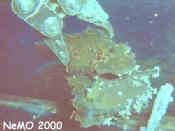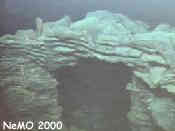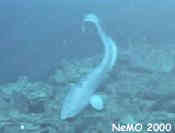| |
Science
Report:
ROPOS dive
549 returned to the Marker 33/Cloud vent area to do more biological sampling
using the biobox and suction sampler, and to put out microbial traps to
be retrieved next year. Large numbers of crab larvae were found over Cloud
vent by a particle sampler, which pumps large volumes of water through a
filter.
Tube worms that first colonized
the 1998 lava flow at Nascent vent have now grown to over 1 meter long.
In previous years, there were marked differences between the biological
communities at different hydrothermal vent sites. This year there are
still differences, probably mainly due to vent fluid chemistry, but those
differences are becoming less pronounced as new species continue to colonize
and spread on the new lava flow. Some new species are taking advantage
of the cooler vent temperatures that we are finding this year. On the
other hand, the microbiologists on board have found that the Marker 33
vent still has large numbers of hyperthermophiles (microbes that thrive
at up to 90 degrees C), even though the temperature measured at the vent
has decreased to 34 C this year from 78 C last year. Obviously, there
is still plenty of hotter habitat for these microbes below the seafloor.
By late afternoon, ROPOS
was back down for dive 550 to extend our Imagenex sonar survey southward
along the 1998 eruption site.
|
|

ROPOS sampling
a rock with limpets and protozoan mats from Marker 108.

A lava arch south of the Joystick Vent.

Rattail fish near Marker
33.
|
|

